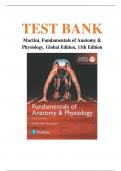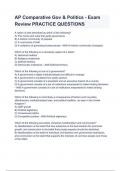TEST BANK
Martini, Fundamentals of Anatomy &
Physiology, Global Edition, 11th Edition
,Contents
1. An Introduction to Anatomy and Physiology
2. The Chemical Level of Organization
3. The Cellular Level of Organization
4. The Tissue Level of Organization
5. The Integumentary System
6. Bones and Bone Structure
7. The Axial Skeleton
8. The Appendicular Skeleton
9. Joints
10. Muscle Tissue
11. The Muscular System
12. Nervous Tissue
13. The Spinal Cord, Spinal Nerves, and Spinal Reflexes
14. The Brain and Cranial Nerves
15. Sensory Pathways and the Somatic Nervous System
16. The Autonomic Nervous System and Higher-Order
Functions
17. The Special Senses
18. The Endocrine System
19. Blood
20. The Heart
21. Blood Vessels and Circulation
22. The Lymphatic System and Immunity
23. The Respiratory System
24. The Digestive System
25. Metabolism, Nutrition, and Energetics
26. The Urinary System
27. Fluid, Electrolyte, and Acid—Base Balance
28. The Reproductive System
29. Development and Inheritance
,Chapter 1 An Introduction to Anatomy and Physiology
Multiple Choice Questions
1) The analysis of the internal structure of individual cells is called
A) cytology.
B) histology.
C) embryology.
D) physiology.
E) anatomy.
Answer: A
Diff: 1
Skill: Level 1 Questions: Reviewing Facts and Terms
2) The study of the general form and superficial markings of an organism is called anatomy.
A) gross
B) surface
C) systemic
D) regional
E) surgical
Answer: B
Diff: 1
Skill: Level 1 Questions: Reviewing Facts and Terms
3) The study of the superficial and internal features in a specific area of the body is called anatomy.
A) surface
B) regional
C) surgical
D) pathological
E) radiographic
Answer: B
Diff: 1
Skill: Level 1 Questions: Reviewing Facts and Terms
4) Anatomical features that change during illness are studied in anatomy.
A) gross
B) surface
C) microscopic
D) pathological
E) regional
Answer: D
Diff: 1
Skill: Level 1 Questions: Reviewing Facts and Terms
5) The study of the liver is to gross anatomy as the study of the liver cell is to
A) physiology.
B) regional anatomy.
C) cytology.
D) systemic anatomy.
E) radiographic anatomy.
Answer: C
Diff: 1
Skill: Level 1 Questions: Reviewing Facts and Terms
, 6) The study of the first two months of development is termed
A) histology.
B) embryology.
C) cytology.
D) pathology.
E) organology.
Answer: B
Diff: 1
Skill: Level 1 Questions: Reviewing Facts and Terms
7) The study of the function of specific organ systems is called
A) systemic physiology.
B) organ physiology.
C) cell physiology.
D) pathological physiology.
E) histology.
Answer: A
Diff: 1
Skill: Level 1 Questions: Reviewing Facts and Terms
8) Cardiovascular physiology is an example of
A) histophysiology.
B) organ physiology.
C) systemic physiology.
D) pathological physiology.
E) physiological chemistry.
Answer: C
Diff: 1
Skill: Level 1 Questions: Reviewing Facts and Terms
9) Which of the following is arranged in correct order from the most COMPLEX to the SIMPLEST?
A) cellular, tissue, molecular, system, organ, organism
B) molecular, cellular, tissue, organ, system, organism
C) tissue, cellular, molecular, organ, system, organism
D) organ, organism, molecular, cellular, tissue, system
E) organism, system, organ, tissue, cellular, molecular
Answer: E
Diff: 1
Skill: Level 1 Questions: Reviewing Facts and Terms
10) Which organ system provides support, protection of soft tissue, mineral storage, and blood formation?
A) integumentary
B) muscular
C) skeletal
D) nervous
E) endocrine
Answer: C
Diff: 1
Skill: Level 1 Questions: Reviewing Facts and Terms






